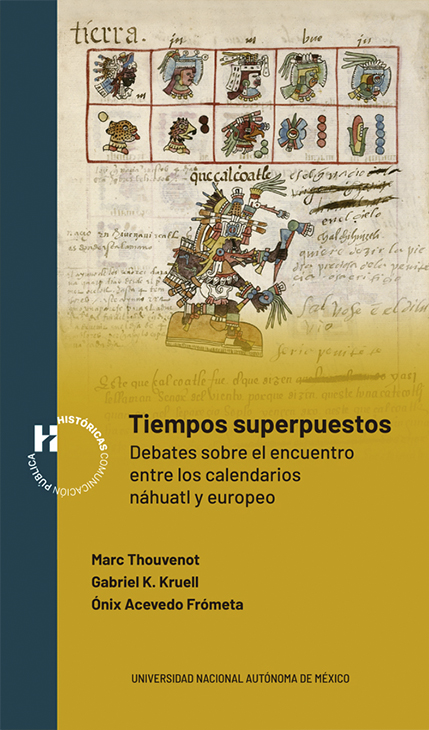
Marc Thouvenot
Gabriel K. Kruell
Ónix Acevedo Frómeta
Tiempos superpuestos
Debates sobre el encuentro entre los calendarios náhuatl y europeo
ISBN 978-607-30-8880-0
Colección
Debates y Herramientas
Basados en los ciclos naturales, los calendarios constituyen artefactos fascinantes. Creados hace miles de años para medir el paso del tiempo, observar periodicidades, fechar acontecimientos, organizar la vida y dar sentido a la existencia, estas invenciones culturales encierran en su estructura el saber, la historia, las tradiciones y las costumbres inmemoriales de las civilizaciones humanas. Los calendarios de Mesoamérica son ejemplos destacados de esta riqueza y muestran la sofisticación y precisión con la que computaron, no sólo los ciclos astronómicos del Sol, la Luna y Venus, sino también el periodo de gestación humana. Tiempos superpuestos explica de manera accesible la estructura y el funcionamiento del calendario náhuatl y describe, con numerosos ejemplos e imágenes, su significación cultural. A través su lectura será posible comprender la diversidad de hipótesis que existen sobre las correlaciones entre los calendarios náhuatl y europeo. Los autores desarrollan un interesante debate sobre cuestiones que dividieron a los cronistas y frailes españoles en el siglo XVI y que confrontan a quienes investigan los calendarios hasta hoy. Este libro también nos muestra los procesos de silenciamiento y erradicación de las cuentas del tiempo sufridos por los mesoamericanos a manos de los religiosos evangelizadores. Tras la conquista, los pueblos originarios perdieron mucho más que unos simples calendarios como forma de contar y registrar el tiempo. Les fue sustraído algo enormemente profundo: aquello que le daba sentido y valor a su vida, les recordaba su grandeza y marcaba su destino.
Based on natural cycles, calendars are fascinating artifacts. Created thousands of years ago to measure the passage of time, observe periodicities, date events, organize life, and give meaning to existence, these cultural inventions keep within their structure the knowledge, history, traditions and age-old customs of human civilizations. Mesoamerican calendars are outstanding instances of this richness and convey the sophistication and precision with which they estimated not only the astronomical cycles of the Sun, Moon, and Venus, but also the period of human gestation. Overlapping times explains, in an approachable manner, the structure and functioning of the Nahuatl calendar, and describes, with various examples and images, its cultural significance. Through its reading, it will be possible to understand the diversity of hypothesis surrounding the correlations between the Nahuatl and European calendars. The authors engage in an interesting debate on the issues that divided the Spaniard chroniclers and friars in the sixteenth century, and that continue to trouble those who study the calendars even today. This work also portrays the processes of silencing and uprooting of timekeeping suffered by the Mesoamericans at the hands of the religious evangelizers. After the conquest, the indigenous peoples lost much more than mere calendars to count and record time. They were deprived of something profoundly significant: that which gave meaning and value to their lives, that which reminded them of their greatness, and marked their fate.
Introducción
I. El tiempo náhuatl
El mundo del tonalli, "día", "suerte”, “destino"
El mundo del ilhuitl, "día", "fiesta", "veintena"
II. El calendario europeo en el siglo XVI y el problema del “bisiesto náhuatl"
El “bisiesto náhuatl”
El debate sobre el “bisiesto náhuatl” hasta nuestros días
III. Superposición de los tiempos
Superposición de los años
IV. Correlaciones calendáricas modernas
V. Debate entre los autores
Deshacer el mito de la unicidad
Marc Thouvenot
Reformas prehispánicas, manipulaciones coloniales e invenciones modernas
Gabriel K. Kruell
Palabras finales, a manera de conclusión
Recursos bibliográficos
Glosario de términos nahuas
Relativos al tiempo y al calendario

